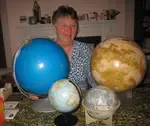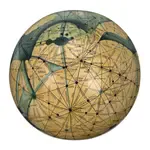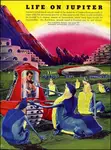- Home
- Comets
comets
[ + link to: What to see on comets ]
In the fiction of the Old Solar System, comets appear "larger than life". Their features - coma, nucleus, tail and eccentric orbit - are exaggerated for purposes of the story. They still match reality qualitatively, but quantitatively you get plenty of poetic licence.
Stid: You said it! Like the exaggerations of the OSS asteroids all over again, only more so, if that's possible. I've read tales which portray life on a comet - civilizations, even! That requires a stretch of the imagination as big as the one you need to make for the OSS' absurdly crowded asteroid belt and for conditions of near-Earth-normal gravity and atmosphere on Asperus and Iskar...
Zendexor: Yes, well, this is fiction, you see. Fiction with rather elastic rules. But that doesn't mean no rules.
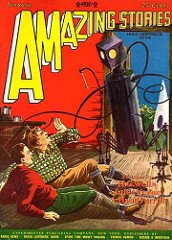
Stid: Remind me to ask you what the rules are. So that my jaw doesn't keep dropping in shock when I read (for example) The Comet Doom in which we're told of a threat that the entire Earth is going to be pulled into a comet's coma.
Zendexor: It was, let's face it, an unusual comet.
At the nucleus of that comet, we learned, there was a solid core formed eons ago by long accumulations of meteoric material. There was air and water upon that core, though little of either, and it was lighted by the intrinsic light of the surrounding coma, and heated more or less by electrical radiation also from the coma...
(Since the comet spent most of its time wandering through interstellar space, the amount of this available "electrical radiation" is surprising. Poetic licence, again.)
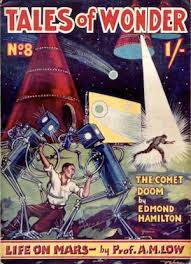
The vast clouds of deadly gases in the comet's tail and head did not touch the solid core, and on that core life had sprung up. That was but natural, given a setting fit for the propagation of life. The theory of Arrhenius, according to which life-spores constantly traverse the universe and evolve into living creatures on whatever planet they strike, applies equally well to the comet's solid core. The life-spores had fallen there, also, and had grown through ages of evolutionary change into a race of intelligent active creatures. They were not men, not human in form, but their science was more than human...
Stid: I can buy all that - just - but it's the size of the comet, big enough for its coma to swallow Earth, that I can't accept.
Zendexor: I had trouble with it too, but then I thought, maybe I'm not paying proper attention to the details given in the story. The coma may be huge but that doesn't mean the nucleus is planet-sized.
Stid: It would have to be planet-sized to pull the Earth.
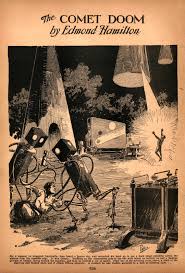
Zendexor: No, no, this isn't just a straightforward gravitational attraction. It's more a ballistic thing. The evil comet-people sever the attraction between the Earth and the Sun, by means of their selective control of gravity, in an attempt to grab the Earth by positioning their own world at the right place and time to catch our world as it spirals outwards on its new path.
Harlei: Will you two stop arguing about these practical points of world-stealing? What's important is the setting, and how readable or likeable the story is.
Zendexor: The setting is Earth - we never reach a scene actually on the comet. As for readability, well, this is early Hamilton (written in 1927 - just a year after he started publishing). Clunky though his prose mostly was at that stage of his career, I find that the setting on Lake Erie sticks in the mind. I have read the story twice, which says something for it.
Your phrase "readable or likeable" is quite revealing - one could make an interesting distinction between the two. I'd put it this way: "readable" is more objective; "likeable" suggests a commitment by the reader to put up with the failings of a much-liked author.
But no such allowances need be made for the next work I intend to discuss.
captain future's tightest corner
Stid: You mean, this next author is both likeable and readable -
Zendexor: It's the same author, actually. Fifteen years later in his career. And the work is not a short story but a novel - the only novel I know of that's largely set on a comet.
Out of all my experience of reading the novels about Captain Future, if I had to cite the one that's most impressively plotted, I'd plump for The Comet Kings.
The adventure is a skilfully graded series of shocks and surprises, of turns of fate and twists of perception, which all turn out to make sense as the fantastic truth is revealed stage by stage.
Ships are disappearing from the space lanes, drawn by a mysterious power to the nucleus of Halley's Comet -
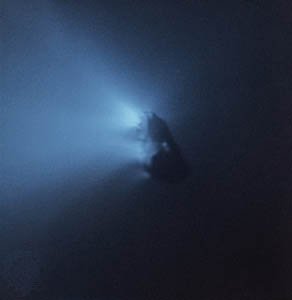 not quite what you get in the story
not quite what you get in the story...a small green world, blanketed by thick forests. It was drenched in the brilliant, unearthly glare of the glowing coma that completely surrounded it.
At one point upon this small green world, there was a star-shaped white city. And they were being dragged straight down toward that city, whose alabaster domes and towers and streets rushed up toward them with fearsome speed.
Captain Future and his crew are imprisoned, and look out through the window of their prison at a scene of beauty, the full sinister significance of which is not immediately apparent:
Curt saw that in the wide streets and green gardens moved many of the natives of this comet world, afoot and in six-wheeled power vehicles. They were all fair-haired folk, beautiful women, stalwart men. And all of them glowed with that dazzling, uncanny radiance of electric force. They seemed like angels of light inhabiting some strange celestial metropolis.
Down upon the alabaster city poured a flood of white brilliance from the sky. For the sky of this comet world was the flaring aura of the comet's nucleus. Completely enclosing this hidden world, this nebulous coma arched across the heavens like a firmament of scintillating white fire.
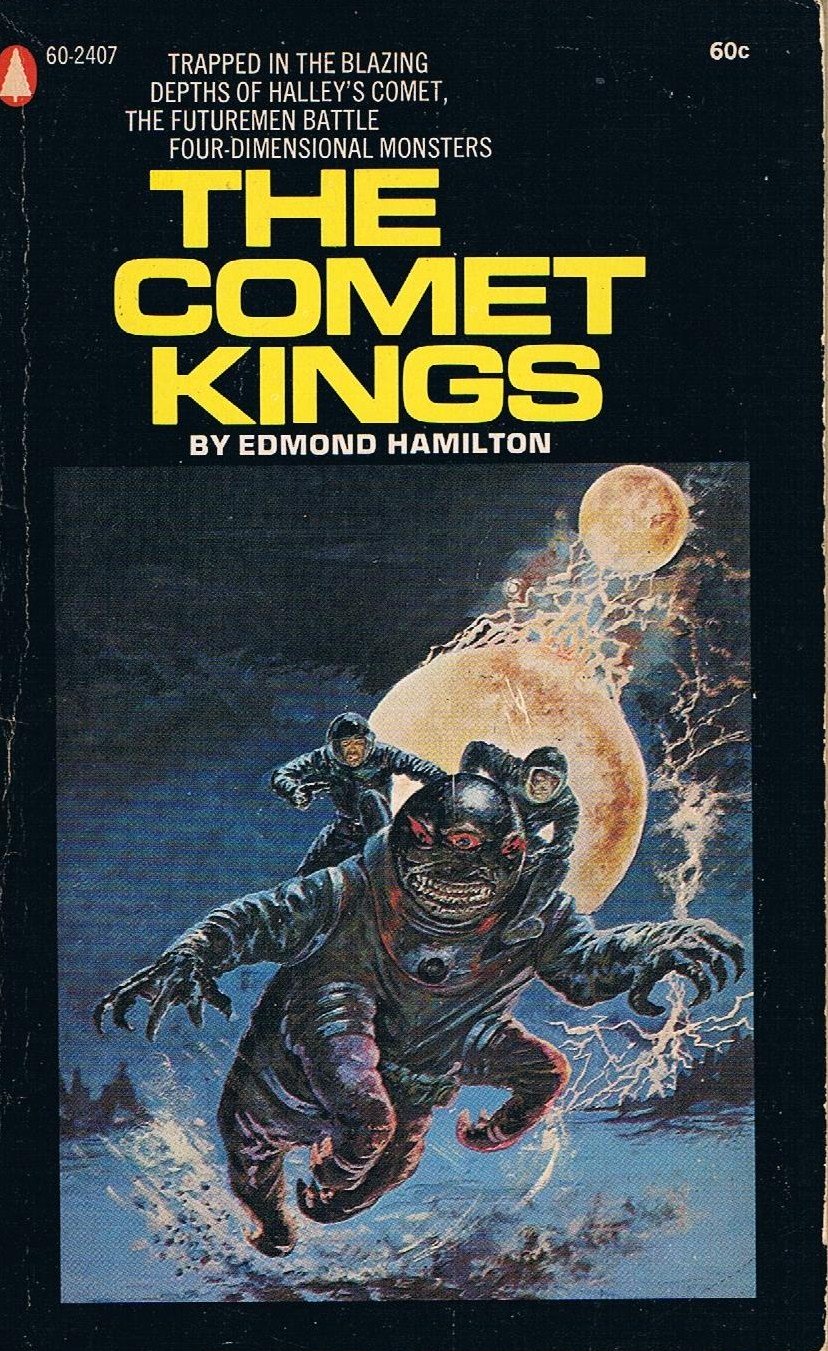 woefully inaccurate and inadequate cover illustration
woefully inaccurate and inadequate cover illustrationThe electrically charged inhabitants - the Cometae - include some who are friendly and some who are hostile, but all are in thrall to a vaster power. We are shown, bit by bit, how and why this is so. The odds against Captain Future go up and up. Eventually we learn that he is pitted against the forces of another universe, who are trying to steal energy from this one, in a trans-dimensional theft reminiscent of that described in The Gods Themselves and Uranian Gleams.
The shadowy creature before him now delivered its ultimatum.
"You can help us willingly with all your knowledge of this universe, and be rewarded by electric immortality. Or you can refuse. In that case, we will strip your mind of all knowledge and then destroy you immediately."
Curt's brain seethed with impotent rage. Yet he knew that anger against the Allus was foolish. They, the utterly alien offspring of a strange cosmos, saw no wickedness in the monstrous theft of energy they proposed. The morality of his cosmos was completely outside their minds.
With such alien beings, parley would be futile. The only answer to their plan was to destroy them. Yet how could that be done? Never had Curt Newton felt so helpless. His body was petrified by the mental grasp of the Allus upon his brain. Even had he been free, how could he harm creatures who seemed wholly immaterial shadows?
"You cannot harm us in any way." Ruun read and answered his thoughts. "No weapon of this universe could make the slightest impression upon us. I advise you to see the folly of resisting our will."
Captain Future decides he must seek an opportunity to kill himself, as the only way to avoid forced collaboration. But it's no use.
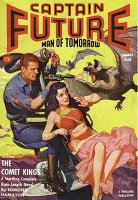
"Do you really think that we are as easy to deceive as that, Earthman? I thought I had made you understand our mastery over you."
Curt realized that Ruun had read the desperate plan he had formed, even as he had formed it!...
"It is regrettable that you did not choose to cooperate willingly with us," the alien being's mental words continued. "It will require needless time to strip your mind... But I perceive now that this is what we must do, and then destroy you."
The reader really gets to wonder at this point, "How the heck is C.F. going to get out of this one?"
In my view the author deserves credit for setting himself such a challenge. It's daring for a writer to stack the deck against his protagonist so hugely, it's creditable that he resolves the plot without recourse to some cheating deus ex machina, and it's engrossing to read how Curt Newton triumphs fairly by the use of his wits and the abilities of his companions, against such appalling odds.
And when you have finished the tale you will carry away with you memories of the city Mloon - the electrified Cometae with their curse of immortality - the glowing jungle - the citadel of the Allus - the Allus themselves, with their linking threads of shadow.
Of course you'll need to go into early-teenage mode if you are to read this book as it ought to be read. But you'll find it's worth it.
Stid: Well, I'm sold. But one more thing. The size of the nucleus of Halley's Comet. Does the story give a clue to it? It says the world is small, but how small?
Zendexor: One clue: Grag and Otho have to journey "scores of miles" from Mloon to the Allus' citadel at the North Pole. My impression is that the comet world is the size of a respectable asteroid, say 100 or 150 miles in diameter. A lot bigger than the real Halley's Comet, of course. But then, that's not the only difference between Captain Future's scene and ours!!!
Anyhow, that's it. Make the most of The Comet Kings, that's my advice, because, so far as I know, there aren't any other novels set on a comet.
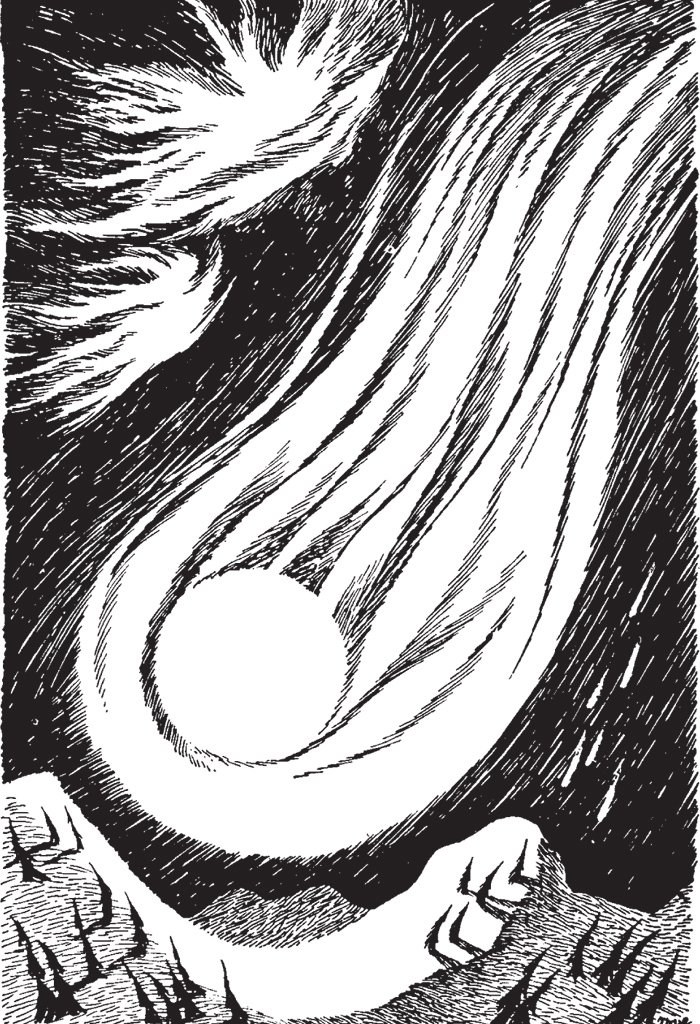 Comet in Moominland
Comet in MoominlandHarlei: I know a couple of tales that include in some sense "hitching a ride" on or getting necessary supplies from a comet. Spacehounds of IPC and Old Faithful. And don't forget good old Comet in Moominland... seriously, I loved that tale. A small child certainly learns from it what a comet looks like - a star with a tail.
hoyle's hard science and its fantastic conclusion
Zendexor: Moving on to adult literature, we come at last to the most hard-scientific treatment of cometary life. Comet Halley is a long, profound, fascinating novel. It was written by a famous astronomer, and its hero is named after the most famous of scientists.
Isaac Newton's thoughts turned back to... his own mention of the OKLO reactor in Gabon. The initial discovery by French nuclear scientists of large concentrations of fission products in rocks two thousand million years old had been greeted with scepticism by experienced scientists the world over, experienced scientists like himself...
But now Professor Newton sees the link between this idea and a recent claim by one of his students that signals had been received from a comet...
Stid: "Professor Isaac Newton", eh?
Zendexor: And to stretch the coincidence further, he's at Cambridge too - though he is Cavendish Professor, not Lucasian Professor as was his seventeenth-century namesake.
The OKLO natural reactor really existed, by the way. It's not an invention of Fred Hoyle's. But as far as I know, what follows is an invention, or extrapolation, of Hoyle's - the idea that this natural reactor was biological in origin:
...under natural conditions you would expect all manner of neutron poisons to prevent a critical fission situation from ever being reached, even in a rich uranium ore, and even at the U-235 concentration of two thousand million years ago. Yet the French had eventually proved their point and won the day, leaving the problem of neutron poisons unresolved.
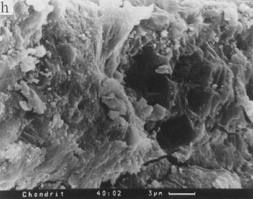
The resolution had come when an American paleontologist had visited the site of the OKLO reactor. He noticed that particularly high concentrations of uranium were associated with fossilised bacterial colonies. Hitherto unknown to nuclear scientists, there are species of bacteria which precipitate uranium from solution in water, so as to build a shell of uranium around themselves... A particularly striking example, discovered by the Americans, was a colony that would have needed only a change in shape to have gone critical...
A similar solution... would also dispose of the heating problem inside comets...
For that was the problem: comets spend most of their time way out in the far reaches of the outer solar system, where life would freeze without a heat source.
Stid: That's not the only problem. All right, I can imagine bacteria on a comet - but intelligent life? A civilization capable of sending signals? Isn't this pure fantasy or else Captain-Future-style juvenilia?
Zendexor: Ah, but in Hoyle's book it is the comets themselves that are alive.
"...Sensors all over the surface of every comet, like eyes - like a thousand eyes, or a million eyes...
"Not biological eyes, of course... electronic eyes. Why not, Isaac?"
"Electronic eyes need a manufacturing industry. To separate their materials - elements like selenium, semi-conductors and so forth."
"Still, why not? Biological cells are especially efficient at separating the different elements. Your own argument about biological nuclear reactors inside comets depended on exactly this point. Or did I get you wrong, Isaac?" Waldheim persisted, still with his quiet, humorous smile.
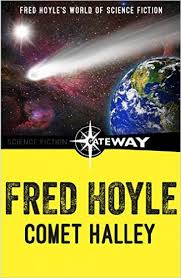
"There would have to be some kind of wires or conducting channels connecting the frozen surface to the warmer insides," Isaac Newton continued, "otherwise the information from the sensors couldn't be processed."
"Again, why not? You know, Isaac, you are beginning to have the look of a man who is hard-pressed in an argument. A desperate look is starting to glaze your countenance."
And so the argument goes on, two great brains striking sparks off each other so that the reader witnesses the development of an awesome theory.
Harlei: Reminds me faintly of Anderson's Epilogue -
Zendexor: Except that that was about machine evolution, whereas this is more a half-way house between what we think of as organic and what we think of as mechanical. More like the Ghepions in Uranian Gleams, maybe. But still, I see what you mean, Harlei. It blurs the distinction between organic and inorganic - and that is a wonder-rousing blur.
I want to stress that Comet Halley gives the reader much more than mere speculation. There is adventure and mystery too. 400 pages of varied fascination, including well-drawn characters, dramatic events, powerful satire about the corridors of power, the Prime Minister and research councils, the American and Soviet leadership...
Plus, there is a particular extra challenge that the author sets himself. His plot allows an outrageous recurrent event, apparently impossible to explain - I refer to the vision which occurs several times, for instance on pages 62 and 144. For a long time the characters in the book can only cope with it by not thinking about it.

Frances Haroldsen was at the rear of the party. She had known Mike Howarth too well to have any wish to see his body sprawled in death, under what appeared to be outrageous and mysterious circumstances, so she held back in the antechapel when the others moved forward into the Chapel proper. She turned and looked back the length of the antechapel towards the statue of the first Isaac Newton. The statue was at first in shadow. Then it brightened as a shaft of moonlight illuminated the plinth. Frances Margaret continued to watch with a weird sense of anticipation. Almost as if fulfilling her expectations, the statue brightened unnaturally. Suddenly it was glowing and flaming orange-red, ten feet tall, with a face like the Greek mask of Tradegy. Giving a muffled scream, Frances Haroldsen rushed towards the outer door which gives onto Great Square and immediately collapsed on the threshold there.
When a thing happens which seems an offence against reason, what is a scientist to do? Eighty pages on from the scene in Trinity College Chapel, we find the issue still un-discussed and utterly unresolved.
"Hopefully that's the last bug in your programme, boss. Let's give it a go."
She punched the computer start button and watched for a while. Then, with satisfaction - since the computer continued to function - Frances Margaret stepped back from the table and hitched up the sleeves of her sweater.
"At least it functions this time. It shouldn't be long now."
The printer started to operate. They watched as the numbers came out, with Frances Margaret standing in a better position to compare their calculated (T,Y) pairs with the comet's (X,Y) pairs.
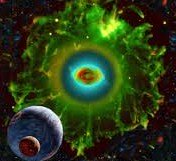
"My God, they're the same. Our numbers and the comet's numbers. Up to now I didn't really believe it, I suppose. But they're exactly the same," Frances Margaret whispered. When the printer had finished disgorging numbers, she tore off several sheets which she handed Isaac Newton.
Isaac Newton reached for the sheets, but it was not Frances Margaret who stood there handing them to him. It was an object very tall, and glowing a bright orange colour, with a grotesque face like the Greek mask of Tragedy. Almost immediately the image cleared and he could see Frances Margaret again, but not before he felt a sharp flash of searing heat. Frances Margaret's face was screwed up with fear.
"I saw it again. You were it," she shouted....
It is a daring feat for an author to include such a challenge in his plot. The risk is that credibility will be undermined. Hoyle gets away with it because his science is so convincing and his plot so strong - strong enough to hold the reader till finally the explanation for the apparitions is given. And the reward for having achieved this, is it gives us an insight into the methods and the powers of the intelligence which mankind has encountered...
Poul Anderson, "Epilogue" (Analog, March 1962); Isaac Asimov, The Gods Themselves (1972); Raymond Z Gallun, "Old Faithful" (Astounding Stories, December 19334); Robert Gibson, Uranian Gleams (2015); Edmond Hamilton, "The Comet Doom" (Amazing Stories, January 1928); The Comet Kings (1942); Fred Hoyle, Comet Halley (1985); Tove Jansson, Comet in Moominland (English translation 1951; original 1946); E E "Doc" Smith, Spacehounds of IPC (1931, 1947)
See the History of Hopes for a reference to life on comets published in 1828.






